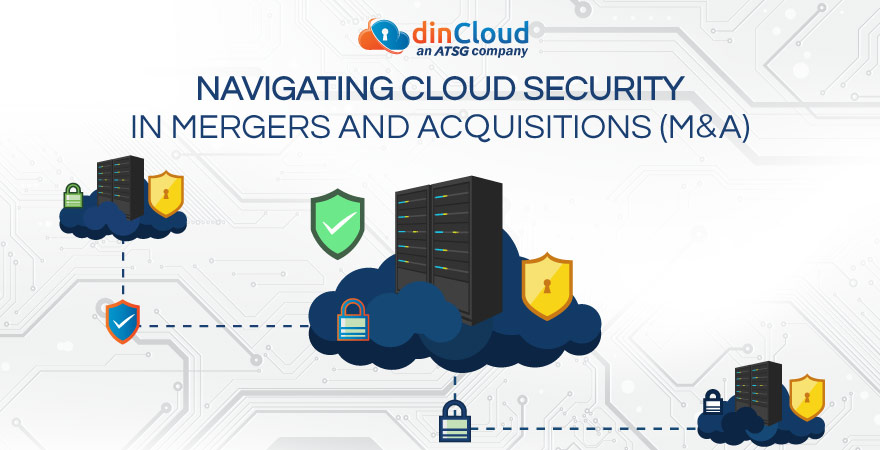The business environment is getting fiercely competitive. Amidst such stiff competition, and in a bid to tap new market opportunities quickly, organizations are increasing pivoting towards Mergers and Acquisitions (M&A).
Instead of “setting up shop” right from scratch, it is often a very successful strategy to merge with a business that already has its presence in a target market, or acquire the company altogether.
A lot of recent M&As have yielded good results, both in terms of commercial success, and the ability of businesses to serve a broader target audience. Having said that, Mergers and Acquisitions (M&A) are also a planning nightmare, with so many variables at play.

In this post, we will discuss the challenges associated with M&As related to organizations that have migrated to the Cloud, in one form or the other. We will also touch upon the good practices that, if followed, can greatly mitigate the various risks involved.
Let us begin by underscoring the issues that organizations in an M&A scenario stand to confront, if they fail to chalk out a workable strategy for the cloud environments of the entities involved.
Related: 3 Ways IT Can Benefit from a Merger and Acquisition
Brand and Reputation
In most M&As, a lot of brand equity is at stake. A few wrong steps and a brand’s equity can erode to an irreparable extent. M&As are closely watched and monitored by customers, investors, shareholders, regulators and other stakeholders.
Revenue Losses
Poorly planned and executed M&As between organizations that rely on Cloud infrastructures can also result in revenue loss, which may come in the form of downtime. Such incidents defeat the whole purpose of entering into an M&A in the first place.
Legal and Regulatory Violations
It is quite possible that the organizations involved in the M&A are operating in different jurisdictions altogether. As a result, a completely different set of laws and regulations may apply to the cloud infrastructures of those organizations.
Any grave violations of the laws and / or regulations can have serious ramifications for the entities involved. This can also adversely impact the tight timelines and deadlines that have been set for achieving key milestones during any M&A.
Now, let us move over to the common mistakes, which enterprises that are in an M&A scenario, tend to commit, in the specific context of cloud environments.
Related: 3 Key Factors to a Successful Merger and Acquisition
Traditional IT Security Approaches
Even if both the entities in an M&A are using the cloud infrastructure of the same Cloud Service Provider (CSP), the two cloud environments could still be miles apart. Each cloud deployment has its own configuration, priorities and security preferences.
So, the traditional approach of simply superimposing the cyber security practices and controls of one organization over the other will not work. Instead, an in-depth mapping of the cloud security mechanisms of all the entities involved is extremely important.
Presumption of Lesser Risk Quotient
If both organizations that are in an M&A are operating in the Cloud, a presumption that the risk element would now be lower can be very detrimental to the whole process. There needs to be an objective assessment of the disparities and gaps in security mechanisms.
This detailed evaluation of the cyber security risks and vulnerabilities is equally important, even if the organizations are hosting their IT infrastructures at the same Cloud Service Provider (CSP). The reason is that there could still be major gaps in configurations.
Related: Mergers and Acquisitions: Why They Fail
Slackness in Technical Due Diligence
An objective analysis of M&As that have not gone as planned has revealed a visible absence, or slackness towards technical due diligence. Ideally, this process should start as soon as the official go-ahead has been awarded for the M&A process.
It is pertinent to mention that the sooner this process is kicked off, the clearer picture will emerge with regards to the cloud infrastructures of the entities involved. The early detection, and remediation of security gaps will create a lot of ease down the road.
Reliance on any One Organization’s Tools
This is yet another roadblock which most organizations tend to face in an M&A. In most of the cases, it is the acquiring company’s cloud security tools, or the larger company’s ones that get “pasted” to the smaller company involved in the M&A.
Related: Key Insights from Mergers and Acquisitions Trends Report 2018 from Deloitte
A “one size fits all” approach does not work in most business scenarios, but this is particularly true in the case of cloud security. Instead, the cloud security of the consolidated organization needs to be re-evaluated from scratch, taking into account the overall picture.
Conclusion
Towards the conclusion, let us highlight some key elements that can potentially make Mergers and Acquisitions (M&A) a success.
- The ability of cloud security teams of all the entities involved to map the entire cloud infrastructure, and identify any potential gaps or vulnerabilities.
- It is important that the cloud security tools of the entities can effectively scale up to encompass the entire cloud environment of the new entity, post M&A.
- Unified visibility is extremely important for the cloud environments of the entities involved, at every stage of the whole journey.
- Post merger or acquisition, as the case may be, the cloud environment of the newly formed entity could grow exponentially. It is vital to introduce automation of cloud security mechanisms, especially the ones around threat detection.
All M&As are hectic, complex and time taking. If both the entities involved in an M&A have cloud environments, this does not imply that it will be an effortless transition. Although things will be much easier this way, proper planning and execution would still be needed.
Contact dinCloud, an ATSG company, whose cutting edge cloud solutions can make your Merger and / or Acquisition much smoother.


